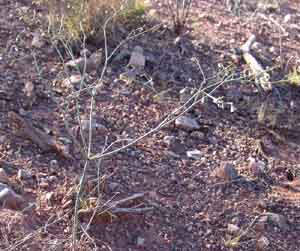Skeleton Weed (Eriogonum deflexum)
Main source: Dimmit, Mark, "Polygonaceae (buckwheat family)", in Phillips, Steven& Patricia Comus, eds., 2000, A Natural History of the Sonoran Desert, Arizona-Sonora Desert Museum Press, pp. 231-2
 The buckwheat family has many species in the Sonoran Desert, including quite a variety of the genus Eriogonum (called "Skeleton Weed", though that name is given to a variety of other kinds of plants as well), but the one most conspicuous in our area is the species deflexum, the plant to which we habitually give this name.
The buckwheat family has many species in the Sonoran Desert, including quite a variety of the genus Eriogonum (called "Skeleton Weed", though that name is given to a variety of other kinds of plants as well), but the one most conspicuous in our area is the species deflexum, the plant to which we habitually give this name.
At left see one example species (click on the image to enlarge it). No leaves can be seen here -- the entire visible structure is the inflorescence of the plant. Typically, one inflorescence arises out of an inconspicuous basal rosette of leaves, and then it branches several times. These florescent stems bear flowers at each node.
Here, to the right, a somewhat better view of the flowers may be had -- again, click on the image to enlarge it. You can see that the skeleton has an inverted-cone shape, and that some of the flowers have already ripened to a rusty brown color. The whole plant (minus its basal leaf-rosette, which withers as the inflorescence grows) will remain as a skeleton for up to a year or more.
Below, a close view of the flowers, some young, some drying out. While the particular plants photographed here come from the flanks of our Red Tank, we have seen Skeleton Weed in its greatest profusion in the floodplains of Hot Springs Canyon. There, after good Fall flow downstream, Skeleton Weed seeds germinate in the fall with the other winter annuals, but the flowers only appear in the summertime (mid-July, in the photographs seen here). When a large crop flowers and then dries out, a diffuse but memorable rusty glow covers the ground of the flood plain.

In August of 2004, we encountered a second species in lower Hot Springs Canyon, when a substantial flooding in the small side-wash just downstream from the Windmill carried an array of seeds which produced this sudden explosion of plants, below -- the skeleton Weeds stand out here by virtue of their pale gray color (a product mainly of the flowers):

These plants, detailed at left, are definitely a different species from the ones at the top. They branch out from the base, have a narrower inverted-conical profile, and much more extensive leafing from the base on up the stems. Click on the image for a close-up of the leaves.
The flowers of this species are also distributed rather differently from  those of the first, as shown in the image to the right; Click on the image for a close-up of flowers
those of the first, as shown in the image to the right; Click on the image for a close-up of flowers
We encountered a third species on December 30, 2004, while driving in Lower Pool Wash. This one presented a strikingly red aspect, as evident in the photo below: (click on the image to enlarge it)
This stand had not been evident in early October. At left, you can see its dried-up basal leaves (click on the image to enlarge it).
Here is a view of its flowers/seedlings. (click on the image for a close-up.) These are very tiny seedlings -- you'll have to use the close-up view to get much of any sense of them at all.




